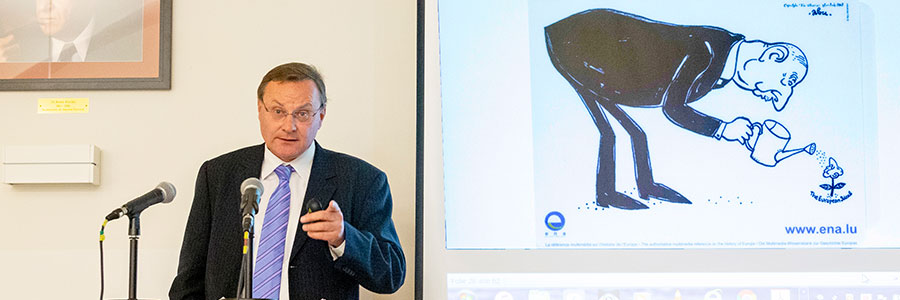Abstract

Von Saint Germain bis Lissabon - Österreichs langer Weg in das Vereinte Europa 1919-2009
Mit diesem Buch werden Österreichs Beziehungen zu Europa und zur europäischen Integration sowie seine fünfzehnjährige EU-Mitgliedschaft seit 1995 in mehreren Kapiteln übersichtlich und zusammenfassend dargestellt. Das Buch bietet ausgehend von der langen Beschäftigung und den umfangreichen Vorarbeiten des Verfassers einen kompetenten Abriss des komplexen und wechselvollen Verhältnisses beginnend mit einem Österreich, welches nur über geringen außenpolitischen Handlungsspielraum in den 1920er Jahren verfügte und in den 1930er Jahren europapolitisch und international auf verlorenem Posten stand: es bewegte sich zwischen wenig aussichtsreichen Paneuropa-Idealen und Mitteleuropa-Konzeptionen sowie „Anschluss“-Ideen, eine Entwicklung, die schließlich 1938 zur Einverleibung in das Hitler Reich führte.
Im Folgenden geht es um Balanceakte zwischen Westorientierung und Neutralität (1947-1960), d. h. der Teilnahme am Marshall-Plan, der Gründungsmitgliedschaft in der OEEC 1948, der Aufnahme in den Europarat 1956 sowie – mangels besserer Alternativen – in die EFTA 1960 und nach Scheitern der Assoziierungsverhandlungen (1964-1967) um die vorläufige Lösung der Freihandelsabkommen mit den Europäischen Gemeinschaften 1972. In der Zeit der SPÖ-Alleinregierung unter Bruno Kreisky erfolgte eine Integationspolitik in Wartestellung (1972-1983), die von zaghaften Neuansätzen zur Annäherung in der Kleinen Koalition SPÖ-FPÖ (Sinowatz-Steger) (1983-1986) gefolgt wurden. Der zweite „Alleingang“ läuft an in den Jahren 1987 bis 1993. Die Verhandlungen und Einigungen mit Brüssel sowie der EU-Beitritt (1993/94-1995) folgen.
From Saint Germain to Lisbon
Austria’s Long Road to United Europe 1919-2009
This comprehensive book project will focuse on Austria's relations to Europe in general and to issues of European integration specially (after 1945) as well as on Austria's membership within the European Union (EU) covering the last fifteen years (1995-2009). Ten chapters will show the developments over decades in a chronological way. The first will concentrate on Austria's small room for political manoeuvre between concepts of Middle Europe, Pan-Europe, the Anschluss Question and the occupation and annexation by Nazi-Germany (1918-1945).
The second chapter deals with Austria's participation in the European Recovery Programme (ERP) and the Organization of European Economic Cooperation (OEEC) reflecting the context of trade liberalization and economic rehabilitation (1947-1953). The third chapter will focuse on the intended arrangements with the European Coal and Steel Community (ESCS) - the first go-it-alone policy - and the entry into the European Free Trade Association (EFTA): partial integration and free trade, which was a tightrope act between western orientation and neutrality (1955-1960). The fourth chapter shows the unsatisfactory Austrian membership within EFTA and the attempts of EEC-assocation (1961-1967). This failed in the end and free trade remained as a substitute solution (1967-1972), which will be presented in the fifth chapter. The sixth one demonstrates the Austrian integration policy of "wait and see" (1972-1986) and the seventh the second go-it-alone-policy (1987-1993) aiming at full EC-membership. Chapter eight sheds light on the negotiations and agreements with Brussels (1993-1994) and chapter nine on the implementation of the EU-entry (1994-1995).
The last chapter chapter (Austria as a member of the European Union from entry to the Lisbon Treaty 1995-2009) includes three stations:
1. Working in EU-institutions, economic and currency integration and
partial security policy adapation (1995-1999);
2. Political disappointments and failures as well as continuities of a moderate security policy (2000-2003); 3. Normalization, the defeat of the Constitutional Treaty, frustration with the EU and the come back of national populism (2003-2009).
Phase 2 and 3 will show high and low points, the EU-Council presidencies of 1998 and 2006, the EU 14-sanctions (2000), the failed process of EU constitutionalization in the context of different crises within and without the EU and their effects on Austria.
Projekt-ID
ProjektleiterIn
Projekttitel
English Translation of the publication by the author Michael Gehler with the english title "From St. Germain to Lisbon. Austria's Long Road from Disintegrated to United Europe 1919-2009" (publication)